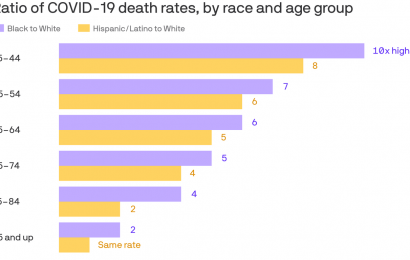Body mass index as a standard measure of healthy or unhealthy weight, is once again being called into question with the American Medical Association recommending physicians deemphasize BMI in patient care and employ other ways to address weight.
In adopting the new direction and policy last week, the AMA’s board of delegates said the “AMA recognizes issues with using BMI as a measurement due to its historical harm, its use for racist exclusion, and because BMI is based primarily on data collected from previous generations of non-Hispanic white populations.” In January, the American Academy of Pediatrics advised, however, that BMI is the most appropriate clinical tool to make the diagnosis of obesity in children.
Kate Bauer, associate professor of nutritional sciences at the University of Michigan’s School of Public Health, says BMI is a hotly debated topic that has physicians and public health experts striving to reach a consensus on effective, respectful and thoughtful ways to discuss, address and treat weight control issues.
What are the drawbacks to BMI when it comes to doctors and patients discussing and addressing weight and weight control?
For many people, BMI is a weak measure of their current health and well-being. It would be more useful if physicians focused on patient behavior and experience: How do patients feel about their current eating habits? Do they desire to be more physically active? What is their sleep like? These are things that are important for long-term health and that we can make fairly good inroads into improving. These conversations may result in patients participating in behavioral weight management or pharmacotherapy or surgical treatments, but that decision is then reached through a more informed process than if we just said that a patient’s BMI is X, therefore they should do Y.
Additionally, we know that weight and BMI are such fraught topics. There’s a really high risk that if a provider is excessively or inappropriately focused on BMI, patients will shut down, the provider/patient relationship will be weakened and, in some cases, patients may begin to engage in unhealthy behaviors, such as going on a fad diet, in an effort to lose weight.
Finally, we know that some physicians inappropriately identify patients’ high BMI as the cause of other health problems, which leads to misdiagnosis and inappropriate treatment. This lack of effective health care for patients with higher BMIs is one of the reasons that people with higher BMIs have poorer health.
Are there positive elements to BMI?
BMI has some utility in the clinical setting. Some patients like to discuss BMI and find it a useful marker of their health trajectory. For others, rapid changes in BMI may indicate another underlying health problem or an adverse reaction to a treatment. We don’t need to throw BMI out, we just need to stop assuming that it is the be-all, end-all measure of health.
Could you explain more about the AMA and others’ concerns over BMI’s failure to take body types and diverse races and ethnicities into account?
There are a lot of intersecting issues with respect to the racial, ethnic, gender and geographical contexts in which BMI rose to use and has remained in favor as a measure of health. Because BMI does not distinguish muscle from fat, people with different body compositions, or even different distributions of fat throughout their bodies, can have the same BMI. Taking this further, because our genetic ancestry can influence our body composition, people with different ancestries can have different body compositions, and thus different health risks, yet the same BMI.
However, our distinctions of which BMIs are healthy vs. unhealthy are based predominantly on studies of individuals with European ancestry. This leaves many groups being inaccurately classified as at risk or not at risk. As a very practical example, individuals of Asian ancestry experience elevated risk of type 2 diabetes and cardiovascular disease at lower BMIs than individuals of European ancestry. If we used the cutpoint for health risk that only applies to Asians for the entire population of the U.S., many, many more people would be considered unhealthy.
The AMA is advising physicians to reevaluate their application of BMI for patients and consider alternative methods for obesity. What are some of those alternatives?
There are other ways to measure individuals’ body fat, or adiposity, although some of them are inconvenient or unreliable when conducted in the doctor’s office. Waist circumference may be one of the simplest measures of adiposity to add to a physical exam, and it can provide important information about whether someone stores fat in their abdominal area, which can be an indicator of higher risk for cardiometabolic disorders. Overall, however, provider-patient decisions regarding interventions to reduce BMI are best made in the context of respectful conversations that consider patients’ mental and physical health, health behaviors and desire to change.
Any thoughts, insight on why policies and conversations about weight and health care providers’ approaches are shifting?
Nearly two decades ago, the “war” on obesity began in response to the rising prevalence of individuals with higher BMIs in the U.S. At this time, our understanding of the causes and outcomes of higher weight and weight gain were fairly poorly understood, and our primary mode of treatment was motivating and educating people to change their behavior, which is rarely successful in the long-term. I think over time, people have gotten tired of our obsessive focus on weight and thinness, and more research has emerged showing that you don’t have to have a BMI in the “healthy” range to be healthy, and that stigma against people with higher BMIs and an excessive focus on having a lower BMI can be as harmful to our health as excess weight.
I also think our country’s increasing recognition of how medical research and practice has excluded and marginalized many populations, while centering around whiteness as the norm or ideal, is driving our shift in perspective. I used to hear from colleagues that social norms around Black women preferring larger or rounder body shapes were harmful and got in the way of women losing weight to be “healthier” (e.g., look more like white women). Meanwhile, appreciating your body for the size it is, is one of the most healthy things you can do. Now that we know better, I am hoping that we do better.
With rates of obesity and related illnesses steadily increasing in children and adults, what should we be focusing on when it comes to healthy weight, losing weight, overall health and how we as a society, from individuals to health care, view weight and health?
On an individual level, we need to focus much more on mental health and health behaviors than the number on the scale. So many people would be better off having a healthier emotional relationship with food—being able to enjoy food, eat when they’re hungry and stop when they’re full—regardless of their BMI. On a broader societal level, we have to stop judging individuals whose bodies do not meet our idea of what is “ideal.” This attitude only causes harm to all involved. Finally, on a research and intervention level, we have to focus on understanding and addressing the conditions that limit families’ access to nutritious food and cause unhealthy relationships with food including corporate promotion of non-nutritious foods, poverty and discrimination.
University of Michigan
Posted in: Medical Condition News | Healthcare News
Tags: Body Mass Index, Cardiometabolic, Cardiovascular Disease, Children, Diabetes, Diet, Doctor, Food, Genetic, Health Care, Medical Research, Medicine, Mental Health, Misdiagnosis, Muscle, Obesity, Pediatrics, Poverty, Public Health, Research, Sleep, Type 2 Diabetes
Source: Read Full Article


